Gwalior tourist guide of historical places and accommodation
Gwalior more commonly known as the city of Scindia's is wonderful tourist destination. The historical city of has a range of magnificent sculptures, rock temples, historical monuments like the magnificent Fort, Jai Vilas Palace, archelogical and other museums. You would find all about this city in this article.
Gwalior
Located on the geographical fringe of Madhya Pradesh, Gwalior is 321 kms south of the Delhi and 423 kms from Bhopal (Capital of Madhya Pradesh). The city serves as the administrative headquarters for the division & district of Gwalior.
This historical city was founded by a king named Suraj Sen. Gwalior was named after a saint called 'Gwalipa' who is believed to have cured a deadly disease of the King Suraj Sen.
The history of this city dates back to 8th century. Gwalior has several historical attractions. Among them are primarily the magnificent fort, mosque made of sandstones, rock temples, sun temple, fascinating statues and beautiful museums.
Apart from all the historic monuments Gwalior also aquires a significant position in the history of Indian music owing to been the birthplace of the greatest Indian musician Tansen.History of Gwalior
Gwalior has been ruled by several dynasties. During the sixth century Gwalior was under the rule of Hunas. Then till 923 A.D it was ruled by Gurjar Prariharas of Kannauj. In the 10th century the throne went in the hands of Kachwaha Rajputs.
In 1196 Qutub-Uddin Aibak conquered the city and it came under the Delhi Sultanate. Later being defeated by Shams-ud-Altamash in 1232 the rule came under him. The Tomar dynasty conquered the city later in the 15th century. During the Tomar dynasty's rule the king Raja Man Singh initiated the construction the magnificent fort of Gwalior. The Gwalior fort is one of the most invincible forts built in India. The city received its famous singing school in the 15th century. It is this school which the legendary musician Tansen used to attend and later became a music legend of the Indian Classical Music.
There was Mughal rule in Gwalior till 1553. Till 1545 Sher Shah Suri who was ruling North India also ruled Gwalior. After his death his son Islam Shah took over. He changed the capital of North India from Delhi to Gwalior. Islam Shah appointed a Hindu worrier Hema Chandra Vikramaditya as the prime minister of his fort. Later after his death, Vikramaditya ruled Gwalior and also other parts of North India. He defeated Akbar in 1556 in Agra.
In 1780 The British gained the control over Gwalior and their rule continued. It is Gwalior where the Queen of Jhansi lost her life during her freedom struggle against The Britishers.
During the eighth century a King named Suraj Sen lost his way in the jungle and reached Gwalior. He found a sage named Gwalipa, sitting on a secluded hill. When he asked him for some water to drink, the sage guided him to a pond. Suraj Sen suffered from the deadly disease of leprosy. On drinking the magical water of the pond his disease was totally cured. Suraj Sen was so grateful to the sage that he requested him to let him give something in return of his favour to his life. The sage just told Suraj Sen to build walls around the hill so as to protect the sages there from wild animals. Suraj Sen kept his promise and built the fort named after the sage. Later the surrounding area of the fort also became popular in the same name Gwalior. This is how the city surrounding the fort got its name as Gwalior.Tourist attractions in Gwalior
Gwalior has an amazing range of tourist attractions. From the beautiful Fort to archaeological museums, there are several attractions that draw domestic as well as international tourists to Gwalior. Some of them are:-Gwalior Fort
This marvellous monument is one of the largest forts in India. The history says that The Mughal King Barbar said that Gwalior fort is "The pearl in the necklace of the forts of Hind".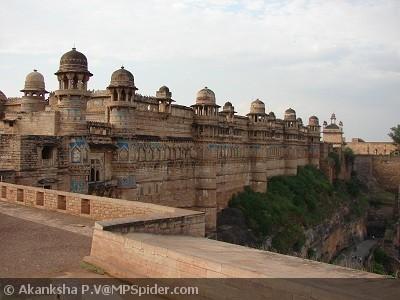
It was built by Raja Maan Singh in the 15th century. It served as the administrative headquarters for various dynasties which had been ruling the city. The fort was built in 2 parts. One part was built during the Tomar rule in the early years and the other part which mainly consists of the Gujari Mahal and the palace was built by the King of Tomar Dynasty, Raja Man Singh for Mrignayani – his favourite and lovable wife.
The entry to the fort is charged by the Government of Madhya Pradesh.
Find the details about the Visiting Timings and Entry Fees to the Gwalior Fort
Read more about Gwalior Fort.
Every day a delightful Light and Sound show is conducted here at the Gwalior Fort. In this show they narrate the whole story and history behind the Fort and the Gwalior city.
Find the details about The Light & Sound Show at Gwalior FortMan Mandir Palace
The Man Mandir Palace as the name suggests is Raja Man Singh's Palace, which he had built inside the fort. It is a part of the Gwalior Fort. This palace in whole is made up of stone walls. With the passage of time it has almost worn out. The palace is totally empty now. The only attraction for the visitors is the beautiful carvings on the stone walls. One spot that occupies a significant position in the palace is the Jawahar Kund. It is believed that the worriers wives used to commit sati in this kund when they got the news of their husbands been killed on the war front.
Another spot to see here is the circular prision where the king used to put the prisoners tied up to the stone walls with the help of strong iron chains.Gujari Mahal
The Gujari Mahal which is now converted to an Archaeological Museum is also a part of the fort. This part of the fort was built by Raja Man Singh Tomar. He totally dedicated this part of the palace for his most favourite and beloved wife Mrignayani who was a Gujar.
This archaeological museum is worldwide famous for its collection of unique and antique sculptures like terracotta statues, inscriptions, paintings, bronze & stone idols etc. The most important sculpture is that of Gyraspur Shalabhanjika in this Gujari Mahal. Saas Bahu Temple
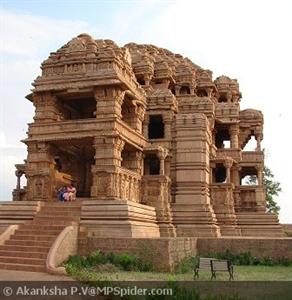
The Saas Bahu Temple was built in the fort in the 9th century. There are two temples in one courtyard in the fort itself. Unlike what the name suggests (saas meaning mother-in-law and bahu meaning daughter-in-law in hindi), the temples are named as short form for Shashtra Bahu. Shashtra Bahu is a name which denotes Lord Vishnu. Hence the two are Lord Vishnu temples.
There are 2 temples here. One is the bigger one and other is the smaller one. The bigger one has beautiful carvings on its walls. The ceiling of this temple has a mesmerizing carving of lotus flower on it. Teli Ka Mandir
Teli Ka Mandir is another temple devoted to Lord Vishnu. It is based on Indo Aryan and Nagara style architecture. This temple is a bit different from other temples here on the fort. The outer look or the roof of this temple has a typical Dravidian look but the sculptures inside the temple are similar to the other north Indian style.
The temple is full of sculptures like several river goddesses, coiled serpents & Garuda which is supposed to be Lord Vishnu's vahana(ride).Suraj Kund
Suraj Kund in the Fort has the most significant place in the history of Gwalior city. This kund i.e pond has the main story behind it. A King named Suraj Sen lost his way in the jungles and he reached on this isolated hill on which the Fort is built. It is believed that he found a sage meditating here on the hill. Suraj Sen was suffering from leprosy since a long time. On seeing the sage out of thirst he requested him to guide him to some place where he could find water to drink. At this the sage directed him to this Suraj Kund. The water of this kund was miraculous. When Suraj Sen drank it not only his thirst was quenched but also his disease got cured. At this Suraj Sen out of thankfulness constructed a tank around the kund and also constructed the fort.Sun Temple
Sun Temple is a temple dedicated to the Sun God. Located in the area called Morar, the temple is a replica of the Konark Sun Temple in Orissa. The temple is made of white marble and contains a beautiful golden idol of the Sun God. When the sun beam fall on this idol in the morning the idol glitters of all gold providing an enlightening and mesmerizing ambience.
The temple has big premises with beautiful garden all around. The environment in and around the temple is very pure, natural and peaceful.Tomb of Tansen
Gwalior is famous for being the birth place of the legendary musician of Indian Classical music, Tansen. In the 15th century there came up the first singing school here in Gwalior from where Tansen learned music. Later he became the most significant musician in the court of the King of Gwalior.
With the passage of time their developed a separate gharana namely Gwalior gharana in the music field. Many of the famous musician have learned music style of this Gharana.
The tomb of Tansen is made in the centre of the city and is one of the significant tourist attractions.Tomb of Ghaus Mohammed
Ghaus Mohammed was a price from Afghanistan who turned into a sufi later in his life. This Price is believed to have helped the Mughal Emperor Babar in the war to win the Gwalior Fort.
His tomb was made in the area called Hazira in Gwalior. The tomb has not turned into a pilgrimage spot in Gwalior. There is no historical importance of this tomb. It is just that the total Mughal architecture and stone work in the tomb is worth seeing. Jivaji Rao Scindia Museum
During the Scindia rule Jivaji Rao Scindia was an important and significant ruler of Gwalior. He contributed a lot towards many of the significant structures in Gwalior. The Scindia's made a separate Palace in the centre of the city. Jivaji Rao Scindia Museum is a part of this palace. Half of the palace is now made a museum and half is still occupied for residential use for the Scindia's.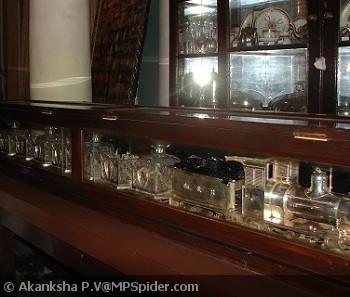
The museum displays amazing piece of works like ornaments of cut glass & crystals, woodwork from Malabar and Madurai, Japanese, Chinese and European art, weapons, miniature paintings, coins etc. The most beautiful piece of display is a silver mechanical train used to serve drinks. The train is placed on a track on the table where the drinks were served.Jai Vilas Palace
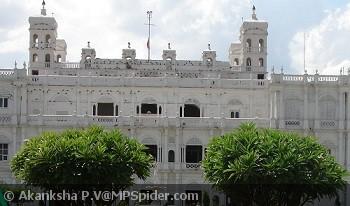
Jai Vilas Palace is a European style palace which is now been converted to museum. This palace as mentioned above was constructed in the rule of Maharaja Jivaji Rao Scindia. The palace is a perfect example of architectural mix of Italy, Tuscan and Corinthian structures. 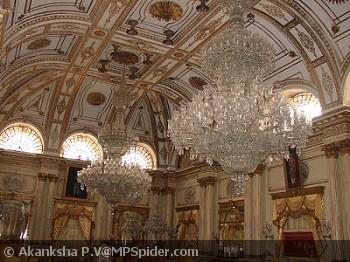
The palace has on display the antique collection of furniture and other fascinations of the Scindia reign. The most marvellous part of the museum is the gold plated halls with gold plated beautifully carved ceilings holding two beautiful glass Belgian chandeliers of tons of weight. The amazing thing is the ceiling is made that strong that it is still holding the heavy weighted chandeliers. This part of the museum is worth seeing and should not be missed at any cost.Other places to visit in Gwalior
There are many other interesting spots in Gwalior for the tourists to visit, not only of historical and cultural importance but also for amusement and fun.
Some such places in Gwalior are:Sun City
Sun City is an amusement park which is recently built. This is an ideal place for families and children. It has a no. of joy rides, food joints, art and culture exhibition counters. One can find a range of rides here from the conventional May Fair lady to Camel ride. Water Park
6 kms from the center of the city is a water park for enjoyment and fun. The water park consists of several water rides, rajasthani choki dhani i.e a rajasthani style of food outlet. Several rajasthani folk dances are also performed here in the choki dhani. Tigra Dam
On the outskirts of Gwalior is a water reservoir named Tigra Dam. This is a perfect picnic spot where in people can have the fun of boating and other fun filled activities.Moti Jheel
This is another picnic spot on the outskirts of Gwalior. Moti Jheel is a pond called jheel in hindi which serves as a good picnic spot.Shopping malls
Gwalior city has a no. of shopping malls also for all those who love shopping like Deendayal City Mall, Salasar Mall, Hi Fi Cenrtal Shopping Mall, DB Malls, Parasmani Mall and Fortune Plaza.
Find more on Shopping in GwaliorHow to reach Gwalior?
There are several ways to reach Gwalior through air, rail and by road.
The details about the air route can be found here.
You can also reach Gwalior through rail. A detailed description on trains to Gwalior can be found at Trains to Gwalior
Read the detailed article on How to reach Gwalior.Climate and Best time to visit Gwalior
Gwalior experiences an extreme climate. Summers (March to June) are scorching hot and temperature may rise up to 50 degrees. July to October is humid and rainy. Winters (October to February) are chilling and temperature can fall up to zero degrees.
The best time to visit Gwalior is during winters i.e from October to March.
Read more..Hotels in Gwalior
Gwalior has a no. of good accomdation facilities for tourists, from 5 star to budget lodges. Some of the hotels are:
1. Taj Usha Kiran Palace Heritage Hotel
2. Hotel Gwalior Regency
3. Central Park Hotel
4. Hotel Sita Manor
5. Hotel Shelter
6. Hotel Landmark
7. Hotel Surbhi
8. Hotel Grace
and many other hotels.
For the list of hotels in Gwalior city please see Accommodation Facilities at Gwalior





